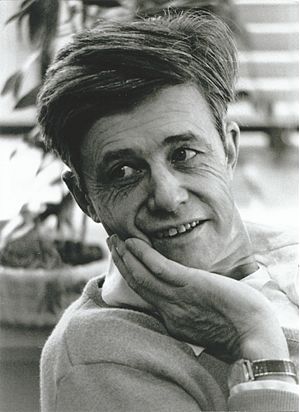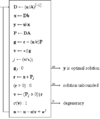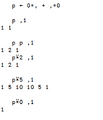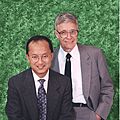Kenneth E. Iverson facts for kids
Quick facts for kids
Kenneth E. Iverson
|
|
|---|---|
 |
|
| Born | 17 December 1920 Camrose, Alberta, Canada
|
| Died | 19 October 2004 (aged 83) Toronto, Canada
|
| Alma mater |
|
| Known for | Programming languages: APL, J |
| Awards |
|
| Scientific career | |
| Fields |
|
| Institutions |
|
| Thesis | Machine Solutions of Linear Differential Equations – Applications to a Dynamic Economic Model (1954) |
| Doctoral advisor | |
Kenneth Eugene Iverson (born December 17, 1920 – died October 19, 2004) was a Canadian computer scientist. He is famous for creating the programming language called APL.
In 1979, he won the Turing Award. This award is like the Nobel Prize for computer science. He received it for his amazing work on programming languages. He also helped make interactive computer systems better.
Contents
Kenneth Iverson's Life
Ken Iverson was born on December 17, 1920. His family lived near Camrose, a town in Alberta, Canada. His parents were farmers who had moved from North Dakota. His family originally came from Norway.
During World War II, he served in the Canadian Army. Later, he joined the Royal Canadian Air Force. After the war, he went to Queen's University. He also earned his Master's and Ph.D. degrees from Harvard University.
Throughout his career, Iverson worked for several important companies. These included Harvard, IBM, I. P. Sharp Associates, and Jsoftware Inc. He passed away in Toronto on October 19, 2004, at the age of 83. He had a stroke while working on a new computer project.
His Education Journey
Iverson started school on April 1, 1926, in a one-room schoolhouse. He was a very bright student. He moved from Grade 1 to Grade 4 in just over a year.
He left school after Grade 9 because of the Great Depression. This was a time when many people had no jobs. He needed to help on the family farm. He also thought that more schooling would only lead to becoming a teacher, which he didn't want to do.
Even out of school, he kept learning. At 17, he took a mail-order course on radios. He also taught himself calculus from a textbook. While serving in the Royal Canadian Air Force during the war, he finished his high school diploma through more courses.
After the war, Iverson went to Queen's University in Kingston, Ontario. The government helped ex-soldiers pay for college. He graduated in 1950 as the top student. He earned a degree in mathematics and physics.
He continued his studies at Harvard University. In 1951, he earned a Master's degree in mathematics. Then, he moved to the Department of Engineering and Applied Physics. There, he worked with famous professors like Howard Aiken and Wassily Leontief.
Howard Aiken helped create the Harvard Mark I. This was one of the first large digital computers. Wassily Leontief was an economist. He developed a way to analyze economies using large tables of numbers, called the input–output model. Iverson helped write programs to work with these large tables on the Harvard Mark IV computer. In 1954, Iverson earned his Ph.D. in applied mathematics based on this work.
His Work and Inventions
Working at Harvard (1955–1960)
After getting his Ph.D., Iverson stayed at Harvard as a professor. He helped start the world's first graduate program in "automatic data processing." This was about how computers could handle large amounts of information.
During this time, Iverson created a special way of writing down computer processes. He needed a clearer way to describe how computers work. He found that regular math symbols were not enough. So, he started adding new symbols and rules. This new way of writing was tested in the business world. It was first published in a paper in 1960.
Working at IBM (1960–1980)
In 1960, Iverson joined IBM Research. There, he met Adin Falkoff, and they worked together for 20 years. Iverson finished his book, A Programming Language, which explained his new notation.
In 1963, Falkoff, Iverson, and Ed Sussenguth used this notation. They created a detailed description of the new IBM System/360 computer. This description helped many people understand how the computer worked. It also got many smart young people interested in Iverson's notation.
In 1965, the team started to build a working version of the language. Larry Breed and Phil Abrams joined the project. They created the first working version of the language in 1965. It was called IVSYS. By 1966, it could be used interactively, meaning you could type commands and get instant results.
Later, the language was officially named APL. This stands for "A Programming Language." The APL\360 system became available to companies outside IBM in 1968. This system was known for being simple, fast, and reliable.
APL was also used to teach computer science. Iverson taught it in high schools and universities. Students loved it so much that some even broke into schools to get more computer time!
In 1969, Iverson started the IBM Philadelphia Scientific Center. In 1970, he became an IBM Fellow. This honor gave him money to invite visiting teachers and professors. They used APL in their own fields, like genetics and geology. Iverson received the Turing Award in 1979 for his work.
While at IBM, Iverson wrote or co-wrote many important books and papers. These included:
- Automatic Data Processing
- A Programming Language
- The Use of APL in Teaching
- The Design of APL
- Notation as a Tool of Thought
Working at I. P. Sharp Associates (1980–1987)
In 1980, Iverson moved to I. P. Sharp Associates (IPSA). This company used APL for its computer services. His son, Eric Iverson, managed the APL language group there.
Iverson continued to improve APL at IPSA. He worked with Arthur Whitney, who was the son of a friend from Harvard. They created a model of APL written in APL itself. This helped simplify the language design. Arthur Whitney also invented a new feature called the "rank operator."
I.P. Sharp Associates added new features to APL. These included complex numbers and "boxed arrays." They also developed a new APL system called SAX. This system followed Iverson's latest ideas for the language.
Iverson also created teaching materials for IPSA clients. He wrote A SHARP APL Minicourse. He also wrote Applied Mathematics for Programmers for computer science students.
Working at Jsoftware (1990–2004)
Iverson retired from I. P. Sharp Associates in 1987. But he didn't stop working on programming languages. He invented a new idea called "fork" in 1988. This made it easier to write certain types of programs.
He wanted to create a new version of APL that was:
- Easy to get and inexpensive for students and schools.
- Able to print on regular printers.
- Able to run on many different computers.
- Simple and powerful, using the newest ideas in APL.
This led to the creation of the J programming language. Roger Hui and Arthur Whitney helped him create it. J was based on Iverson's ideas from his book A Dictionary of APL.
One big difference between J and APL is how it looks. J uses regular keyboard characters (like A, B, C, 1, 2, 3) instead of special symbols. This makes it easier to type and share. Another difference is that J uses words from natural language, like "noun" and "verb," instead of computer science terms.
The J programming language is available for free under a special license. In 1990, Eric Iverson started Iverson Software Inc. Ken Iverson and Roger Hui joined the company. The company later changed its name to Jsoftware Inc. and focused only on J.
While at Jsoftware, Iverson wrote many books. These included:
- Tangible Math
- Programming in J
- Calculus
- Math for the Layman
Awards and Honors
- IBM Fellow, IBM, 1970
- Harry H. Goode Memorial Award, IEEE Computer Society, 1975
- Member, National Academy of Engineering (USA), 1979
- Turing Award, Association for Computing Machinery, 1979
- Computer Pioneer Award (first recipient), IEEE Computer Society, 1982
- Honorary doctorate, York University, 1998
See also
 In Spanish: Kenneth Iverson para niños
In Spanish: Kenneth Iverson para niños
Images for kids
-
Simplex algorithm in Iverson notation
-
J tacit verb for binomial coefficients









